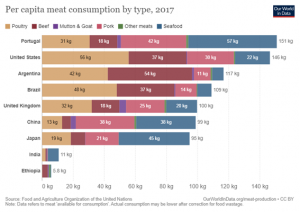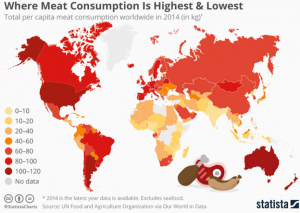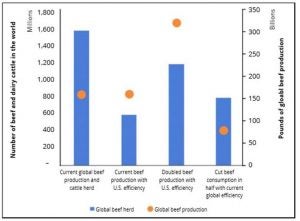The short answer to the title of this article is no. Eating meat in the United States — whether beef, pork, or poultry — is not impacting how other countries develop agriculture. Deforestation is related to beef production, but not global beef production, only the development of this industry in particular countries, specifically in regions such as Latin America.
We frequently see the push of articles from vegans, animal-rights activists, or climate change activists that beef consumption is the leader of deforestation. And although there is truth to elements of that, the blame is wrongly placed on countries with established scalable livestock production — and that misplaced activism tells the U.S., Canada, and European countries that they should reduce their consumption to reduce deforestation.
However, it is highly unlikely that if these countries consumed less beef, that Latin American countries would stop producing beef. In fact, the U.S. has already significantly reduced beef consumption. Just 40 years ago, Americans consumed almost 80 pounds of beef per person each year, now they only consume about 57 pounds each year. The U.S. has even ramped up exports of beef, from 1 percent in 1970 to roughly 11 percent today.
Yet, deforestation has continued to increase. Why?
Latin America and the U.S. have two entirely different consumers of their products. U.S. beef is high quality, grain-fed, well-marbled, and therefore relatively expensive compared to most of the world’s income. Latin American beef, particularly Brazilian beef — one of the largest exporters in the region — is generally considered lower quality, grass-finished, and leaner.
Since this beef is lower quality, and therefore cheaper in relation to developed countries beef, it is primarily going to lower-end markets, such as China, Egypt, Iran, and even other Latin American countries like Chile. U.S. beef is typically exported to higher-end markets like Japan, South Korea, and Taiwan, where consumers have higher income levels and can afford the higher quality meat.

The two largest global consumers of meat are China and India, even though individuals there don’t consume the most per capita, the total of feeding over 1.3 billion citizens in each of those nations increases the overall need for meat. Meat consumption has been connected with increased economic well-being. Meat-focused diets are often more expensive in undeveloped countries since much of their product is imported. It is a good sign that countries that have had historically impoverished citizens are increasing their meat consumption, as this is an indicator that economic conditions may be improving.

Meat consumption also increases the level of dietary nutrition these citizens are getting, so all in all it is a good thing. However, poor practices of beef production may influence poor environmental practices like deforestation. How do we combat the negative aspects while also providing better diets for the globe? Modeling beef production in other regions, particularly Latin America, after U.S. beef production practices can help reduce environmental impacts.
The United States has increased the efficiency of meat production so much that we are able to provide 18 percent of the world’s beef with only 8 percent of the world’s cattle. If other countries were able to increase their beef production efficiency to match the U.S., we could reduce the global herd size by 62 percent and still produce the same amount of beef that we do today. Unfortunately, without developments in the governmental structure, science, and economies of these countries, it is difficult to say how this reduction may be achieved.
All in all, it is not the diets of developed countries that are influencing climate change aspects of global agriculture. So enjoy your steak knowing that when you do, you are increasing the likelihood of others in the globe to one day be able to enjoy a food system like the United States has.

Learn more about how meat is not bad for the environment here.
Michelle Miller, the Farm Babe, is a farmer, public speaker and writer who has worked for years with row crops, beef cattle, and sheep. She believes education is key in bridging the gap between farmers and consumers.



